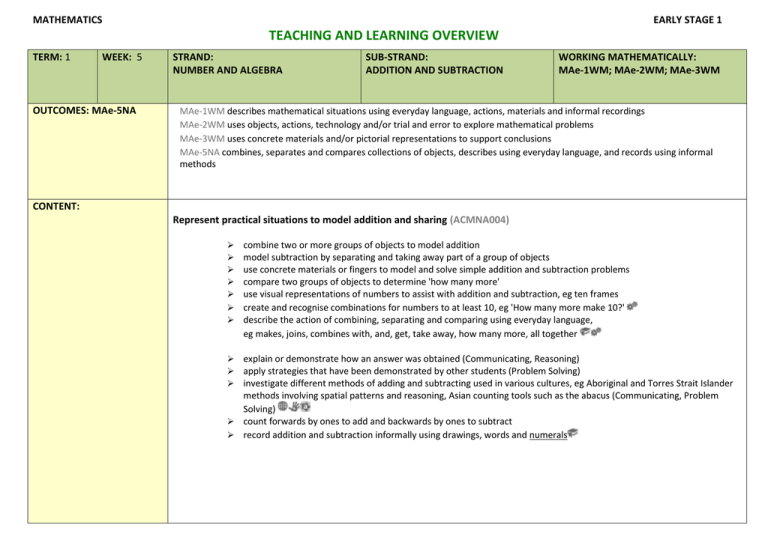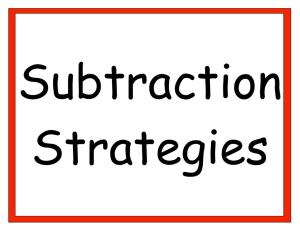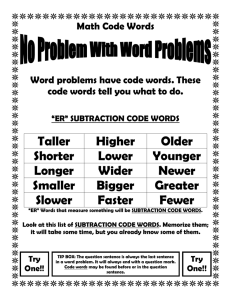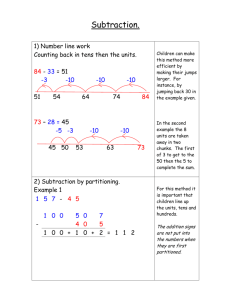AS - ES1
advertisement

MATHEMATICS EARLY STAGE 1 TEACHING AND LEARNING OVERVIEW TERM: 1 WEEK: 5 OUTCOMES: MAe-5NA STRAND: NUMBER AND ALGEBRA SUB-STRAND: ADDITION AND SUBTRACTION WORKING MATHEMATICALLY: MAe-1WM; MAe-2WM; MAe-3WM MAe-1WM describes mathematical situations using everyday language, actions, materials and informal recordings MAe-2WM uses objects, actions, technology and/or trial and error to explore mathematical problems MAe-3WM uses concrete materials and/or pictorial representations to support conclusions MAe-5NA combines, separates and compares collections of objects, describes using everyday language, and records using informal methods CONTENT: Represent practical situations to model addition and sharing (ACMNA004) combine two or more groups of objects to model addition model subtraction by separating and taking away part of a group of objects use concrete materials or fingers to model and solve simple addition and subtraction problems compare two groups of objects to determine 'how many more' use visual representations of numbers to assist with addition and subtraction, eg ten frames create and recognise combinations for numbers to at least 10, eg 'How many more make 10?' describe the action of combining, separating and comparing using everyday language, eg makes, joins, combines with, and, get, take away, how many more, all together explain or demonstrate how an answer was obtained (Communicating, Reasoning) apply strategies that have been demonstrated by other students (Problem Solving) investigate different methods of adding and subtracting used in various cultures, eg Aboriginal and Torres Strait Islander methods involving spatial patterns and reasoning, Asian counting tools such as the abacus (Communicating, Problem Solving) count forwards by ones to add and backwards by ones to subtract record addition and subtraction informally using drawings, words and numerals ASSESSMENT FOR LEARNING (PRE-ASSESSMENT) Fives frames and tens frames: Students represent numbers to 10 using counters and personal tens frames, and identify how many are needed to complete the frame. Alternatively a whole class tens frame can be used by marking out the frame on the carpet and using plates as counters. Where one-to-one matching is not yet taking place students will begin this lesson sequence at the PreFoundation level to reinforce this counting skill. WARM UP / DRILL Ask children to trace around their hands and feet onto coloured paper. Have them label their fingers and toes with the numbers 110. Display the tracings in the classroom and use them as a basis for counting eg by ones, two, tens etc. TENS ACTIVITY NEWMAN’S PROBLEM INVESTIGATION TENS activity covered as part of guided and independent activities as EAS is being addressed in this strand. QUALITY TEACHING ELEMENTS RESOURCES INTELLECTUAL QUALITY Deep knowledge Deep understanding Problematic knowledge Higher-order thinking Metalanguage Substantive communication QUALITY LEARNING ENVIRONMENT Explicit quality criteria Engagement High expectations Social support Students’ self-regulation Student direction Dot cards 1-10, number cards 1-11, numeral cards 0-10, counters SIGNIFICANCE Background knowledge Cultural knowledge Knowledge integration Inclusivity Connectedness Narrative TEACHING AND LEARNING EXPERIENCES WHOLE CLASS INSTRUCTION MODELLED ACTIVITIES Students will be given real life opportunities to add two numbers together to make the whole. Similarly real life subtraction opportunities will also be part of class routines. GUIDED & INDEPENDENT ACTIVITIES LEARNING SEQUENCE Pre Foundation Skills LEARNING SEQUENCE ES1 “Friends of ten” concept is explicitly taught and modelled using playing cards. Students each get a card and have to search through the others in the class to find a “friend of ten” LEARNING SEQUENCE Extension S1 EVALUATION & REFLECTION Emergent: Display a set of numeral cards from 0-10 and a large container of counters. Point to various numerals each time and ask the students to make a pile of that number using the counters. Perceptual: Teen Numbers Plus The teacher prepares a set of dot cards for the numbers 1 to 10 and a set of number cards from 11 to 19, as shown. All dot cards are turned face down, but kept in sequence. In small groups, a student turns over two of the dot cards and states how many dots there are altogether. If the answer is one of the teen number cards, the student removes the number card and the dot cards are turned face down again. Play continues in turn until all of the teen number cards have been collected. Students record addition and subtraction informally using drawings, words and numerals. Figurative: Doubles Instruct the students to use two hands to demonstrate double numbers from 1 to 5. For example, “Show me double four. How many altogether?” In this example the students would raise four fingers on each hand and call out the answer. Students may bring their hands down to count and confirm the total. Students record addition and subtraction informally using drawings, words and numerals. Student engagement: Resources: Achievement of outcomes: Follow up: All assessment tasks should be written in red and planning should be based around developing the skills to complete that task.






